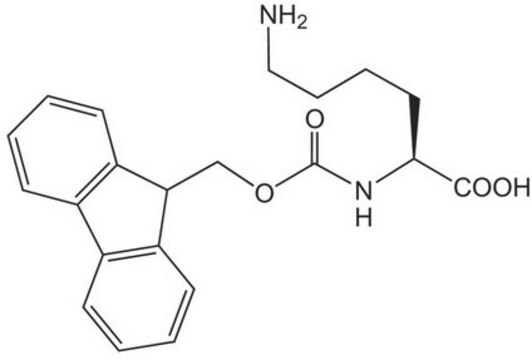QBD10243
Fmoc-N-amido-dPEG®2-acid
>95% (HPLC)
Sinonimo/i:
Fmoc-N-amido-PEG2-COOH, Fmoc-N-amido-PEG2-acid, Fmoc-PEG-acid, Fmoc-PEG2-acid
Autenticatiper visualizzare i prezzi riservati alla tua organizzazione & contrattuali
About This Item
Formula empirica (notazione di Hill):
C22H25NO6
Peso molecolare:
399.44
Numero MDL:
Codice UNSPSC:
12352106
NACRES:
NA.22
Prodotti consigliati
Saggio
>95% (HPLC)
Stato
solid or viscous liquid
Impiego in reazioni chimiche
reaction type: Pegylations
Architettura del polimero
shape: linear
functionality: homobifunctional
Condizioni di spedizione
ambient
Temperatura di conservazione
−20°C
Caratteristiche e vantaggi
Fmoc-N-amido-dPEG2-acid is a monodisperse PEG product that is useful for peptide synthesis. The ten-atom dPEG spacer allows the introduction of a short, hydrophilic spacer onto either end of a peptide chain or between two peptide chains. The flexible dPEG spacer conjugates to peptides using conventional peptide synthesis chemistry. Peptide PEGylation imparts water solubility to hydrophobic peptide chains. Also, PEGylated peptides have expanded hydrodynamic volumes, which can reduce or eliminate renal clearance, and are protected from proteolysis. The combination of decreased renal clearance and protection from proteolysis contributes to longer in vivo circulation times for PEGylated (as compared to non-PEGylated) peptides. Additionally, PEGylation diminishes a peptide′s antigenicity. This product is part of the Fmoc-N-amido-dPEGn-acid (n=2, 3, 4, 5, 6, 8, 12, 24, 36) product series.
Note legali
Products Protected under U.S. Patent #s 7,888,536 & 8,637,711 and European Patent #s 1,594,440 & 2,750,681
dPEG is a registered trademark of Quanta BioDesign
Codice della classe di stoccaggio
11 - Combustible Solids
Classe di pericolosità dell'acqua (WGK)
WGK 3
Punto d’infiammabilità (°F)
Not applicable
Punto d’infiammabilità (°C)
Not applicable
Scegli una delle versioni più recenti:
Certificati d'analisi (COA)
Lot/Batch Number
Ci dispiace, ma al momento non ci sono COA disponibili online per questo prodotto.
Se ti serve aiuto, non esitare a contattarci Servizio Clienti
Possiedi già questo prodotto?
I documenti relativi ai prodotti acquistati recentemente sono disponibili nell’Archivio dei documenti.
Aaron S Anderson et al.
Langmuir : the ACS journal of surfaces and colloids, 24(5), 2240-2247 (2008-01-31)
We report a general procedure to prepare functional organic thin films for biological assays on oxide surfaces. Silica surfaces were functionalized by self-assembly of an amine-terminated silane film using both vapor- and solution-phase deposition of 3'-aminopropylmethyldiethoxysilane (APMDES). We found that
Ananda Kumar Kanduluru et al.
Bioconjugate chemistry, 27(9), 2157-2165 (2016-08-17)
The neurokinin-1 receptor (NK1R) is implicated in the growth and metastasis of many tumors, including cancers of the brain (e.g., gliomas, glioblastomas, and astrocytomas), skin (e.g., melanomas), and neuroendocrine tissues (cancers of the breast, stomach, pancreas, larynx, and colon). Because
Jered C Garrison et al.
Bioconjugate chemistry, 19(9), 1803-1812 (2008-08-21)
The high incidence of BB2 receptor (BB2r) expression in various cancers has prompted investigators to pursue the development of BB2r-targeted agents for diagnostic imaging, chemotherapy, and radiotherapy. Development of BB2r-targeted agents, based on the bombesin (BBN) peptide, has largely involved
Ian W Hamley
Biomacromolecules, 15(5), 1543-1559 (2014-04-12)
The remarkable diversity of the self-assembly behavior of PEG-peptides is reviewed, including self-assemblies formed by PEG-peptides with β-sheet and α-helical (coiled-coil) peptide sequences. The modes of self-assembly in solution and in the solid state are discussed. Additionally, applications in bionanotechnology
Il team dei nostri ricercatori vanta grande esperienza in tutte le aree della ricerca quali Life Science, scienza dei materiali, sintesi chimica, cromatografia, discipline analitiche, ecc..
Contatta l'Assistenza Tecnica.








